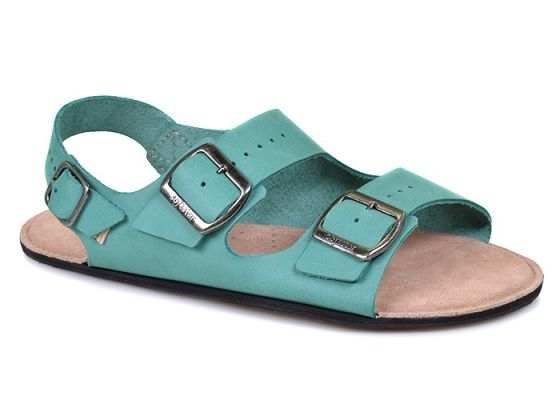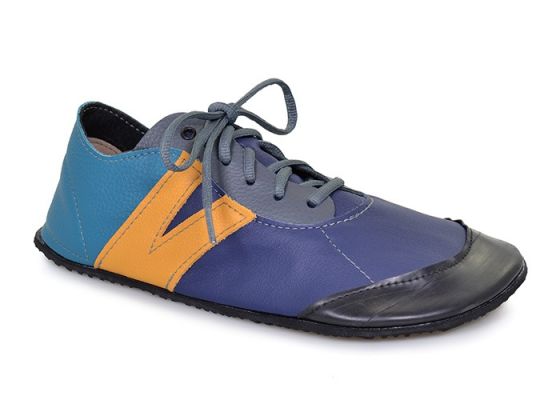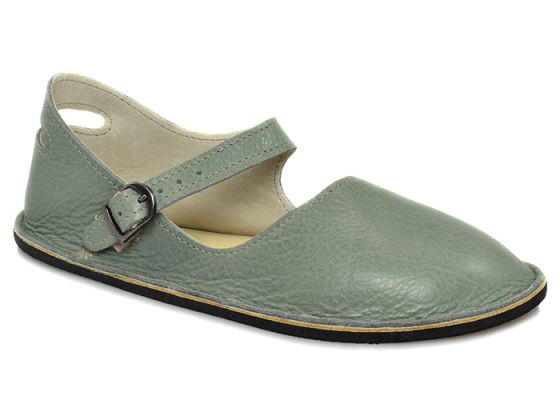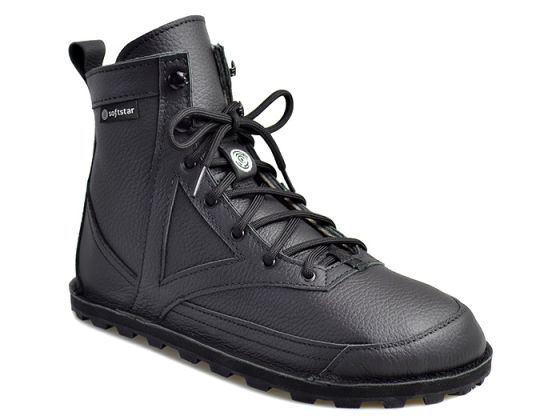Are Barefoot Shoes Good for Flat Feet? How to Strengthen Arches
In my previous post about barefoot shoes for treating plantar fasciitis, I talked about how arch support in shoes weaken the natural arches in your feet. Today's follow-up post is all about how to strengthen arches. Barefoot shoes are good for flat feet because they allow your arches to strengthen naturally. I'll also get into several foot arch exercises and therapy techniques.
To recap the last post, wearing expensive arch supports doesn't address the underlying cause of conditions such as plantar fasciitis. As explained in an article by Dr. Ray McClanahan [1], the strength of an arch comes from weight bearing down from the top when both supportive sides are on an even surface. Pushing an arch up from below is counter-productive.

In my own experience, removing my arch supports and strengthening my feet by switching to barefoot shoes cured my plantar fasciitis naturally. We at Softstar hear similar stories every day from the barefoot shoe community.
"Blueprint your feet, and you'll find a marvel that engineers have been trying to match for centuries. Your foot's centerpiece is the arch, the greatest weight-bearing design ever created. The beauty of any arch is the way it gets stronger under stress; the harder you push down, the tighter its parts mesh. No stonemason worth his trowel would ever stick a support under an arch. Push up from underneath, and you weaken the whole structure. Buttressing the foot's arch from all sides is a high-tensile web of twenty-six bones, thirty-three joints, twelve rubbery tendons, and eighteen muscles, all stretching and flexing like an earthquake-resistant suspension bridge."
Christopher McDougall, from Born to Run [2]
For those with short attention spans, here's how they explain it in Beakman's World. It's poetic how they "remove the arch support" to demonstrate the strength of the structure:
I remember this show being much less annoying in the 90s.
Summary: Why Barefoot Shoes Are Good for Flat Feet
- Strong arches with nice round arcs are a sign that your feet are healthy and less prone to injury.
- Shoes with arch support inhibit your arches from doing their job, leading to flat feet.
- Flat feet are weak feet. The lack of strong arches causes feet to be more prone to plantar fasciitis.
So, do you want strong feet? If so, then the good news is that there may be hope for flat-footers.
"Feet live for a fight and thrive under pressure; let them laze around... and they'll collapse. Work them out, and they'll arc up like a rainbow."
Christopher McDougall, from Born to Run [3]
How to Strengthen Arches
Please note that undergoing any new exercise regimen runs the risk of injury. People with weak arches should be very careful to avoid doing too much too quickly. It is recommended to consult a medical professional first. We make no promises about results.
1. Try New Footwear
According to Dr. McClanahan, modern footwear commonly weakens arches and arch supports aren't the only reason. It's also because of their thick heels that place your feet on a ramp and position the ends of your arches on uneven ground [4]. Pinching toe boxes and toe springs that force your toes to stay in an upward position don't help, either. To promote stronger arches, look for footwear with zero-drop soles with no arch support, no toe spring, and no tight or tapered toe boxes that pinch your toes together. Thin and flexible soles will also help your feet bend and flex naturally.
Bonus tip: if you want to speed up the recovery process, consider trying Correct Toes toe spacers to help increase circulation and restore the natural shape of your foot.
Softstar's barefoot shoes are the best for flat feet because every one of our shoes was designed to follow healthy footwear principles. If you do shop for other brands, check out our free infographic on how to choose barefoot shoes. You can even print it out and take it to the store with you.
Of course, if you want the ultimate footwear for strong arches, you already have it: bare feet! While it isn't always acceptable to go barefoot, doing so a little each day while paying attention to your body's natural signals can do wonders. And remember, if you aren't accustomed to bare feet or minimalist shoes, make sure you know how to transition to barefoot shoes or you'll risk injury.
Need a place to start? Here are some of our most popular styles, all handcrafted in Oregon, USA:
-
 New
Adult Camino Lite Sandal
$140.00
New
Adult Camino Lite Sandal
$140.00 -

 Adult PRIMAL RunAmoc
$190.00
Adult PRIMAL RunAmoc
$190.00 -

 Adult Merry Jane
$140.00
Adult Merry Jane
$140.00 -
 Adult Switchback Boot
Starting at $250.00
Adult Switchback Boot
Starting at $250.00
2. Foot Arch Exercises
These simple exercises, presented in beginner and advanced versions, can be done in your own home. All you need is a penny and a pen! Try doing them for a few minutes each day, increasing as your arches strengthen. Stop if you feel pain, and remember to take a day off here and there to let your muscles rest and recover if they feel sore.
Beginner Version
- Start with your bare foot on a flat surface, toes spread out.
- Place a penny under the ball of your foot and the end of a pen under the middle of your arch (sticking out from the inside of your foot).
- Activate your arch by flexing your arch muscle. You should feel the muscles on the ball of your foot pushing down on the penny, but your arch shouldn't be pushing down on the pen. These tools help you (1) avoid rolling your foot and (2) avoid pressing down with your toes (as an extra tip, you can slide a business card under your toes before doing the exercise–when you activate your arch, you should be able to slide the business card out easily with your fingers).
- Do your best to keep your toes relaxed.
Advanced Version
Once you're ready to move on, you can try this advanced version. It builds on the above exercise to incorporate full body twisting and balance, helping you to maintain proper arches while you move:
- Using the same ideas from above, stand on a flat surface in your bare feet with a penny under the ball of your foot and the end of a pen under your arch. This time, stand with your back a few inches away form a wall or a door.
- Lift your other leg (the one without the penny or pen) and stand on one foot. Use the wall for balance, if necessary.
- Lift one arm and stretch it across your body until you touch the wall or door on the opposite side, maintaining a straight back. Keep your foot straight and your arch on the penny but above the pen. Your arch will want to follow the movement and roll off, but you will need to activate it to stay stable during the movement.
- Lift your other arm and stretch it across the opposite side of your body, still keeping your arch in place.
You can see both of these exercises demonstrated in this video, which also explains how weak arches affect pronation:
3. Massage
Massage therapy is a great way to loosen muscles and help improve mobility in in your feet. As many people with foot pain have discovered, tight muscles in your legs or back can lead to tense foot muscles. All those muscles are connected, so tension in your back can cause tension in your legs which can pull the tendons in your feet and cause stiffness and pain. Getting acupuncture or a professional full body massage are probably the best ways to deal with this, but there are also some simple tricks you can do at home to help keep muscles limber. These are great for loosening up and improving circulation, both before and after exercise:
- Use a Tennis Ball: place a tennis ball under the arch of your bare foot and roll it around, stretching the muscles in your foot and promoting blood flow. You can also roll the ball under your calves and upper legs to work out stiffness and knots. If you feel the tennis ball is too easy, try a lacrosse ball for deeper massaging. This is also demonstrated in the exercise video above.
- Use a Foam Roller: those big overpriced rolls of foam that are now available in every department and sporting goods store are fantastic for self-massage (why a roll of foam costs $30 is beyond us, but they do work wonders—our advice is to not waste money on the more expensive fancy grooved ones because even the simplest rollers work great). The exercises you can do with foam rollers seem to be endless, and there are literally hundreds of free videos online showing how to use them to massage every part of your body. Here's one we picked out that specifically targets foot and leg muscles related to arches and plantar fasciitis:
4. Get Professional Help
Hopefully, these tips will help you prevent, treat or even cure arch pain, such as plantar fasciitis. If you find you have persistent foot pain, if your pain appears to be getting worse or if you believe your problem is more serious than something that can be treated with simple home exercises, then it is strongly recommended that you seek the advice of a medical professional.
An expert podiatrist, physical therapist or chiropractor can explore many other variables that could be affecting your feet and prescribe treatment specific to your needs. Be aware, however, that there are conflicting theories about how to treat foot pain. Many traditional podiatrists will be quick to prescribe expensive orthotics or arch supports rather than seek ways to strengthen your feet naturally, though they may find other issues that need to be addressed that you may have overlooked. It's up to you to decide which treatment method you prefer and to understand the risks involved.
If you do decide to look for a doctor who treats injures by strengthening natural foot function, we're happy to say our friends at Runbare have put together a growing list of "barefoot" doctors around the country. One of our favorite docs, the previously mentioned Dr. Ray McClanahan from Northwest Foot and Ankle, is a leader in the field and we would absolutely recommend him if you live in the Pacific Northwest.
If you have any other tips or stories of your own, feel free to share them in the comments below. Here's to happy feet!
1. Dr. Ray McClanahan. "Arch Support" Correct Toes (August 17, 2012).
2. Christopher McDougall, Born to Run (New York: Alfred A. Knopf, 2009), 176.
3. Ibid, 177.
4. McClanahan. "Arch Support"

Martin is a lifelong runner who began wearing minimalist shoes over 10 years ago when he found they alleviated his chronic foot pain, which eventually disappeared completely. He further studied proper running form through a series of workshops taught by the inventor of Correct Toes Toe Spacers, Dr. Ray McClanahan DPM. Martin has collaborated with several health care professionals to collect and share peer-reviewed studies that show the benefits of minimalist footwear. In his personal life, Martin loves living in the Pacific Northwest because it allows him to enjoy a variety of outdoor activities year-round, including hiking, cycling, rock climbing, surfing and snowboarding.


After working at a heavy labour job standing/running on concrete all day and having to wear heavy warm boots for some years, I noticed that my arches had begun to fall a bit. Oh no! I generally wear flipflops as long as I can in good weather, but the lack support around the ankles which has issues. But I found that over the summer, my feet would get a bit better. I am still waiting to get some soft stars, but have been doing foot exercises which help.
Rather than surgery, is it worth working at arch strengthening exercises. The pen will not fit UNDER the arch. My foot sits down on the pen hard for your basic exercise.
Any suggestions gladly received.
Derek
most recently I have developed a sore (inflamed) plantar fascia. I never had problems with my plantar fascia in my life. I have regular arches I'd say, and upped my mileage to 7-10miles 4-5 times a week about 8 weeks ago.
I've been using barefoot shoes (Vivobarefoot) as footwear (not for running yet!) since June and haven't had any problems so far.
My question: how do I treat my acute inflamed fascia (it is diagnosed as inflamed plantar fascia by a doctor). I guess strengthening my arches is a no-go as long as my condition is acute? Is running ok? I don't have pain when running. if so, how long should I take a break from running, and when should I start with strengthening exercises? Also, are those exercises something that one can check off one's schedule once strong arches have ben established or are toes/arches to be exercised regularly as a runner?
Thanks for your help, and greetings
Flokon
For sure I'm going to follow your exercises and I wonder if this going to solve my shin and calf as well.
Thanks
I have fallen arches and I have pain in my feet and also in my knees and ankles. I wear orthotics but still the pain doesn't go. If I do these exercises will it build my arches and alleviate my leg pain too ? How many months would it take to see the difference
i had a problem with my left foot arch dropped and also near small toe top side a pain was told by docs it might be ligaments or morton nuroma !!! just get a stab pain top left like i have twisted the foot under going with physio but had it now over 6 months does seem to be getting better if ligaments how long i did run and jog a lot but stopped now since this happen.I just walk taken some fitness out of me now, any help or idea would be great
I finally ran into the video listed above that shows the penny/pen exercises. I forced and was cognizant about strengthening the arch for 2 days. My knee pain has slowed down. I am walking barefoot without much pain.
TWO DAYS with the right information can change your life!!!!!
It makes me so mad that the established medical practice is to NOT TRY TO LET YOU STRENGTHEN WHAT YOU HAVE